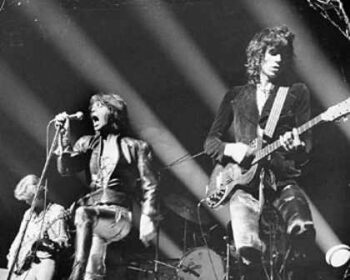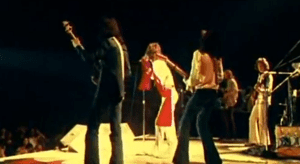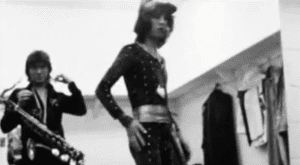
“It’s almost a fairy story, you know.”
–Keith Richards
“Never let the truth spoil a good story.”
–Bill Wyman
***
My gateway high was a compilation album, 1966’s Big Hits (High Tide and Green Grass). In particular, I can recollect driving helter-skelter around the San Fernando Valley in the soft, anything-goes California light, the volume turned up on my cassette deck for “Get Off of My Cloud,” gathering adolescent momentum to deal with girls, enemies, and everyone else in-between. I knew the big hits, of course, and I dug the vibe as much as the music itself but I didn’t really get it and I wasn’t a true Stones fan until a few years later, only after making for myself delirious personal knowledge in the first two-thirds of youth’s greatest trifecta, that is, the sex and drugs parts.
‘Sex, drugs and rock and roll,’ of course, was the sixties generation riffing on wine, women and song— it wasn’t just a jazzy cliché but a lifestyle, if a hedonistic one that left some beautiful corpses along the way. The Rolling Stones, who as a band turned fifty in 2012, have survived almost everybody. That they are still together (more than forty years after their principle rivals, the Beatles, disintegrated) is something of a miracle, what with the hypothetically massive egos involved in playing in (arguably) the greatest rock and roll band of all time. But what Brett Morgen’s fiftieth anniversary documentary, HBO’s Crossfire Hurricane, makes clear is that they made it through the years not just because of timing, talent, swagger, and the projection of a certain sinister image, but also because they were laid-back guys who seemed to really appreciate the fact of their divinely granted lottery tickets, fulfilling a Dionysian dream life far more exhilarating than the lurid fantasies of your most hard-up teenaged wanker.
 A collection of interviews with the band narrated over wonderful archival footage, Crossfire Hurricane begins backstage at a concert in New York City’s Madison Square Garden in July, 1972. The band is promoting their double album Exile on Main St., a period when the Stones were cresting artistically and commercially, as well as having more fun than anyone else on the planet. This is the druggiest time for the band, and its most debauched, rife with babe-swapping and conspicuous orgies (famed photographer Robert Frank was hanging out with the band, filming the beautiful, yet surprisingly dull Cocksucker Blues). In one corner, there’s Bill Wyman eyeing the babes, holding his bass like a phallic ramrod; the young, diffident lead guitarist, Mick Taylor, waiting in the shadows; drummer Charlie Watts looking like he’d rather be anywhere else; Keith Richards, a wicked, puckish rascal, chain-smoking, sniggering at some joke only he knows the punch line for; and Mick Jagger, now changing into a jumpsuit, adjusting his panty-wetting junk in a full-length mirror. When seventies TV personality Dick Cavett describes Mick Jagger as the “supreme sexual object in modern Western culture, a compound of menace and energy, a sadomasochistic freak, and a pussycat,” it sounds pretty close to the mark when the Stones take the stage and Jagger, released into the limelight, bounds, gambols, and flourishes in the flamboyant dervish twirls of a coke-fueled, footloose troubadour. Even if his music means nothing to you, the man has indisputable stage presence.
A collection of interviews with the band narrated over wonderful archival footage, Crossfire Hurricane begins backstage at a concert in New York City’s Madison Square Garden in July, 1972. The band is promoting their double album Exile on Main St., a period when the Stones were cresting artistically and commercially, as well as having more fun than anyone else on the planet. This is the druggiest time for the band, and its most debauched, rife with babe-swapping and conspicuous orgies (famed photographer Robert Frank was hanging out with the band, filming the beautiful, yet surprisingly dull Cocksucker Blues). In one corner, there’s Bill Wyman eyeing the babes, holding his bass like a phallic ramrod; the young, diffident lead guitarist, Mick Taylor, waiting in the shadows; drummer Charlie Watts looking like he’d rather be anywhere else; Keith Richards, a wicked, puckish rascal, chain-smoking, sniggering at some joke only he knows the punch line for; and Mick Jagger, now changing into a jumpsuit, adjusting his panty-wetting junk in a full-length mirror. When seventies TV personality Dick Cavett describes Mick Jagger as the “supreme sexual object in modern Western culture, a compound of menace and energy, a sadomasochistic freak, and a pussycat,” it sounds pretty close to the mark when the Stones take the stage and Jagger, released into the limelight, bounds, gambols, and flourishes in the flamboyant dervish twirls of a coke-fueled, footloose troubadour. Even if his music means nothing to you, the man has indisputable stage presence.
For Stones fans no new ground is broken in Crossfire Hurricane. Like a visual “greatest hits” package it borrows plenty from the Maysles Brothers 1970 masterpiece Gimme Shelter, Charlie Is My Darling (a lesser known documentary about the Stones touring Ireland in 1966), and a wealth of archived concert scenes (including the magnificent Rolling Stones Rock and Roll Circus). We survey the band’s bluesy cover roots; their bad boy press; the fanatical response of female fans urinating in their seats during the band’s early performances; the breakthrough hit “Satisfaction;” London’s Summer of Love; the famous drug bust at Keith’s pad; the death of Brian Jones; Mick Taylor’s hiring; Altamont; the band’s tax issues and the move to the French Riviera; Ronnie Wood replacing Taylor; and finally Keith’s Toronto drug bust being a wake-up call to kick heroin because he loved the band best. The documentary concludes with the mainstream legitimizing of the Stones— no longer dark princes but white knights. Over the film’s credits we fast-forward almost thirty-five years to contemporary footage of a performance, grey-haired, pension-aged, but still kicking.
 So the story we’re talking about focuses on the first fifteen years of the band’s existence. Because let’s face it, by the 1980s New Wave, punk, rap, and synth-pop were ascendant and the Stones were in their forties, culturally irrelevant, a greatest hits band, recycling sixties decadence to sold-out stadiums. You can’t hold this against them too much. They had an astounding twenty-year run (1981’s Tattoo You being their last great album for my money).
So the story we’re talking about focuses on the first fifteen years of the band’s existence. Because let’s face it, by the 1980s New Wave, punk, rap, and synth-pop were ascendant and the Stones were in their forties, culturally irrelevant, a greatest hits band, recycling sixties decadence to sold-out stadiums. You can’t hold this against them too much. They had an astounding twenty-year run (1981’s Tattoo You being their last great album for my money).
Like Elvis, they made their reputation alchemizing an affection for rhythm and blues into a gritty yet finger snapping sound accessible to a larger (and mostly white) record-buying audience. (Besides their musical chops, Jagger concedes learning to dance by admiring Little Richard). Once established, the Stones stayed true to their rock and roll sound, mostly avoiding the segueing zeitgeist movements (psychedelic, prog rock, punk), building on their original sound, evolving musically, experimenting within a successfully established framework, but still mostly providing the ideal soundtrack for getting drunk, and, ideally, laid.
The thing about the Stones is there will never be a rock and roll band with their reach (just as I suppose there will never be another Beethoven, John Lee Hooker, or Miles Davis due to disparate listening tastes, demographic heterogeneousness, and other complex social developments). Today rock and roll is still a viable musical genre but hardly the cultural touchstone it was when the Stones were young and glorious. There’s no question that due to the proliferation of technological options such as iPods and the Internet, as well as the decline of FM radio, rock and roll is forever too decentralized for an apotheosis on the scale of Jagger. Mick and the boys were in the right place at the right time for becoming superstars.
 In fact, one of the qualities that make Crossfire Hurricane so engaging is how it invokes this aura of collective experience. Jagger intones, “You’re merely the catalyst of the crowd.” Aware that an audience is the visceral counterpoint to a band’s energy, the documentary explores the mass psychosis involved in Stones’ concerts: namely women urinating into their pants, and young men rioting in the streets. Tracing the Stones’ trajectory is moving from sixties-generation dissatisfaction into seventies-era narcissism. You can see it in the crowds as much as in the Stones themselves. What you get then from the film, is that in the end, for better or worse, performance was about a good time. “It all comes down to those two hours on stage,” Ronnie Wood affirms. “They’re the reward.”
In fact, one of the qualities that make Crossfire Hurricane so engaging is how it invokes this aura of collective experience. Jagger intones, “You’re merely the catalyst of the crowd.” Aware that an audience is the visceral counterpoint to a band’s energy, the documentary explores the mass psychosis involved in Stones’ concerts: namely women urinating into their pants, and young men rioting in the streets. Tracing the Stones’ trajectory is moving from sixties-generation dissatisfaction into seventies-era narcissism. You can see it in the crowds as much as in the Stones themselves. What you get then from the film, is that in the end, for better or worse, performance was about a good time. “It all comes down to those two hours on stage,” Ronnie Wood affirms. “They’re the reward.”
Jagger explains, “You’re thrust into the limelight in a youth-oriented thing. It’s not about growing up, it’s about not growing up.” This is disconcerting for those who believe the pleasures of life have a time and place. The older I get, the more I find myself fetishizing sixties culture, of which Jagger, Richards, and company were its more riveting ambassadors. I’m addicted to their energy and find myself wondering if something more than their music is at work— could my obsession with their legendary posturing be early onset symptoms of midlife crisis behavior? The years are passing but when I listen to Jagger doing “Street Fighting Man” or “Honky Tonk Women,” age feels like just an arbitrary number, irrelevant, and youth reemerges in my being, manifesting itself as a sensibility, a visceral gut feeling. And then I get it: why the geezers are still on stage, why the show goes on. I’m just a fan, but it feels really good, like anything’s possible. And this is the reason I’ll probably never stop listening to “Street Fighting Man.” The moment might be an illusion and yesterday’s one at that, but it gets me through the day.




